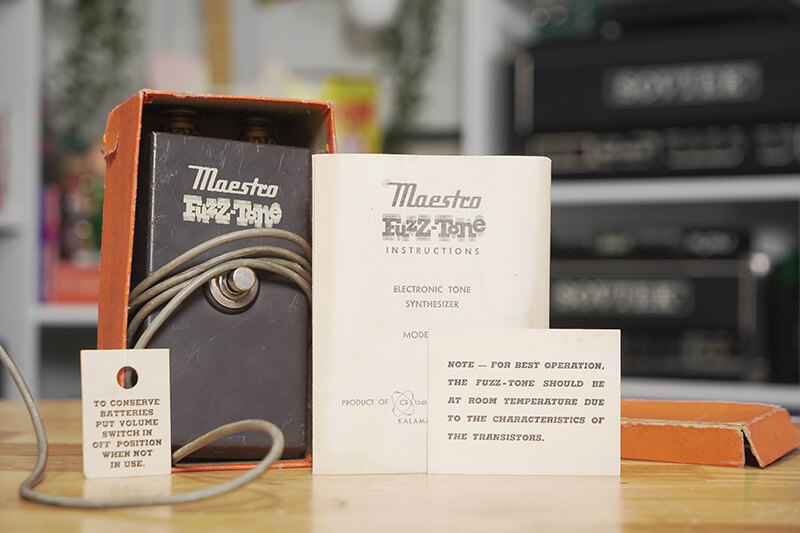A Look at Unique, Cool and Memorable Pedal Box Art Design with Josh Scott from JHS Pedals
Editor’s note – we love JHS Pedals, and we scramble to our phones whenever the notification bells dings each time a new JHS video hits YouTube. One of our favorite bits they do is called “He Has The Box,” in which founder/owner/all-around-good-guy Josh Scott shows off and waxes philosophical about the box a vintage or unique pedal came in. Oftentimes, there’s more to say about the box design and artwork than the pedal itself. So, with that in mind, we asked Josh to show off some of the neatest boxes in his ever-growing collection. Can’t you just smell the cardboard through these pages?
Marshall Supa Fuzz:
This pedal is a version of the Tone Bender that was made by Sola Sound in the 1960s for Marshall; this specific version was released in 1968. This is one of the few fuzz pedals that we can confirm Jimi Hendrix used, other than the Fuzz Face.

Seamoon Fresh Fuzz:
This was a strange distortion/fuzz pedal released in 1973 and manufactured in Berkley, CA. It was the second-ever pedal produced by Seamoon (the first was the Funk Machine envelope filter released earlier the same year). The most notable user was Eric Johnson, who utilized it early in his career.

Dallas Arbiter Trem Face:
Everyone knows about the Fuzz Face, but the Trem Face was a tremolo that Arbiter made during the same era (the late 1960s). The enclosure is identical to the Fuzz Face; coincidentally, these boxes are almost impossible to find.

DeArmond 601 Tremolo Control Unit:
This was the first ever standalone guitar effect unit released in 1947, made in Toledo, OH, by DeArmond. DeArmond was a massively influential company in early electric guitar history, especially with the DeArmond magnetic pickup which was created using the parts of the Model T Ford. The tremolo effect is produced by conductive fluid being propelled in a bean can-sized container inside the enclosure– not an ideal feature for a product that’s meant to be plugged into an electrical outlet.

Maestro Fuzz-Tone FZ-1:
The FZ-1 was the first guitar pedal ever made, released in 1962, which means that this is the first guitar pedal box. The OG, if you will.

Ampeg Scrambler:
The Ampeg Scrambler is an octave fuzz from the late 1960s, and is one of the first gooped pedals, meaning that the circuit inside the pedal is covered in a black epoxy mixture. My favorite use of this pedal is by the band Cactus on their self-titled debut album.

Univox Super Fuzz:
The Super Fuzz is the most iconic octave fuzz ever made and this particular version and box is from the early 1970s. This box features some of my favorite art and branding of all time.

Electro-Harmonix LPB-1:
The LPB-1 (Linear Power Booster) was originally released in 1968. The cheese wedge-shaped box is decorated with a homemade photo montage featuring a young Mike Matthews and friends holding a giant LPB-1.

Digitech Space Station XP300:
The box itself isn’t anything to write home about, until you open it and realize that it houses an original, still-in-the-plastic-wrap, never-been-used Space Station from the late 1990s. Truly out of this world.

Maxon Renometer:
The Renometer was released in the mid-1970s and manufactured in Japan. While these pedals– and their amazing boxes –were produced by Maxon, they were made for and marketed by Ibanez as well. As a result, you have a pedal labeled “Maxon” in a box that says “Ibanez,” and both are technically correct.

Dan Armstrong Musictronics Series:
I’ll admit this is a little bit of a cheat, as I chose a large store display box that holds the full set of Musictronics Dan Armstrong plug-in effects released around 1975: the Blue Clipper (which may be the first op-amp overdrive ever made), the Orange Squeezer (my all-time-favorite compression pedal), the Purple Peaker, the Red Ranger, the Green Ringer and the Yellow Humper. I’m a sucker for this line and its aesthetic.

One of the cooler things about collecting boxes and attaching them to the pedals is that you find ephemera that was supposed to be thrown away– things like hang tags, phone numbers, business cards, sales receipts, warranty forms, addresses to the company headquarters, all kinds of crazy stuff. That’s one of the best parts of pedal collecting, and it also allows you to accurately date the product. The original instructions can also provide useful insight into how weird the world was and how people utilized this kind of guitar effect when it was released.
Basically, the boxes are cooler than the pedals, but the ephemera are cooler than the boxes.
